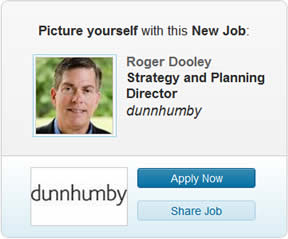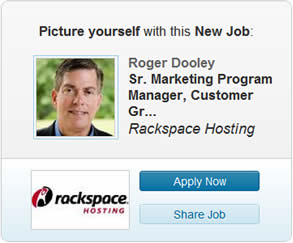Social Personalization and the Doppelganger Effect
 Are you overlooking a way to personalize your ads that goes far beyond the usual “Dear Roger” salutation?
Are you overlooking a way to personalize your ads that goes far beyond the usual “Dear Roger” salutation?
In my recent article, Put Your Customer in the Ad, I mentioned that LinkedIn was using profile pictures for targeted ads. Since then, I’ve been able to capture a couple of examples. The first one surprised me when it appeared, and to generate a second one I had to surf a variety of profiles. Here’s what I like about these ads:
Image personalization
Who could resist looking at an ad that contains their own picture? I suppose once viewers are inundated with them, they’ll be less effective, but for now it’s hard to imagine more eye-catching content. And I think even as these ads become more common they’ll be as attention getting as the often-used images of weird looking guys, weirder looking guys, or bikini babes. While including an irrelevant but eye-catching image may grab the viewer’s attention and garner more clicks (if these ads didn’t work, we wouldn’t see so many of them!), it does nothing positive for the brand.
The Doppelganger Effect
 In my earlier post, I described research that showed even crude representations of a viewer using a brand (created by superimposing an image of the viewer’s head onto a picture of a person drinking a soft drink) created a preference for the brand being consumed. The researchers dubbed the composite image a “virtual doppelganger,” from a German word that refers to a person’s “ghostly double.”
In my earlier post, I described research that showed even crude representations of a viewer using a brand (created by superimposing an image of the viewer’s head onto a picture of a person drinking a soft drink) created a preference for the brand being consumed. The researchers dubbed the composite image a “virtual doppelganger,” from a German word that refers to a person’s “ghostly double.”
The LinkedIn ads may not fully create a virtual doppelganger, but they do help the viewer visualize himself/herself as part of the company. First, the text reads, “Picture yourself…” Then, next to the photo, the viewer’s name and “title” appear, almost in business card format. (Presumably, the title is based on an actual opportunity, though I didn’t attempt to verify that. It would be a letdown to see my name and “Chief Marketing Officer” only to contact the firm and find they were recruiting assistant managers.)
The important factor here is that even contrived visualization of this sort can create a preference.
Targeting
Based on my experience in trying to trigger these highly personalized ads, they are well-targeted. I noticed several layers of targeting, though with LinkedIn’s detailed profiles they could no doubt target in many more ways (and perhaps do). First, I saw ads from companies whose profiles I visited, a good indicator of interest and, perhaps, familiarity. An advertiser might want to cast a wider net, but this approach certainly offers a high click probability.
The next layer of targeting was the type of position advertised, which in my examples are reasonably well-matched to my profile. This is really important – the right title could get clicks even from visitors not engaged in a job search. The wrong title would at best perform poorly and at worst actually damage the advertiser’s image. Imagine, for example, a Fortune 500 CTO who sees a keyword-triggered ad that says, “Picture yourself as a Network Support Specialist!” I’m sure gaffes like this occur, particularly for individuals with vague or uncommon titles, but LinkedIn has put some thought into this.
Improvements
These ads are simple, but I can think of at least one tweak that would amp up the doppelgänger effect. What if the ad was modified slightly so as to simulate an actual business card with company logo, name, title, photo, etc.? A minor change, but one that would add to the reality of the visualization.
Get socialized!
Overall, this modest use of a photo and profile data should greatly increase the effectiveness of these career ads. I would expect them to deliver two main benefits:
- Increased attention and click through rates
- A small lift in company preference
Note that while LinkedIn has direct access to their user profile data, tools are available that let you get the same kind of information when users “connect” with your site or app using Facebook, Twitter, etc.
[Next in the series: How Higher Ed Uses Social Personalization.]

Perhaps the doppelganger effect works with job ads, but I can tell you I would be very turned off by brands (including prospective employers) who used my photo without my prior knowledge or consent. Even in this social age, I still believe in some small zone of privacy and the use of our likeness falls within it. Suppose the individual being targeted isn’t looking for a job, but this would imply s/he is and create all manner of problems with his/her employer. I would probably be less likely to use a product that included me without my permission. Behavioral targeting is intrusive and creepy enough. This takes it to a whole new, unpleasant level.
Good point, Susan. I’m not looking for a job, and I found the personalized ads inoffensive and amusing. I guess if I had a boss looking over my shoulder asking why my photo is in that competitor’s ad, I might be less amused. (“Competitive research, boss!”)
Like behavorial targeting, some users may like it (I’d prefer to see ads for stuff that interests me), and some may be freaked out.
Roger
Hi – this stuff also works very powerfully with social networks data.
You spot really quickly when you see a widget like ‘People in your network also used xxx’ or ‘Join Bob and 250 others with our special offer’.
This works on more than one level – with the facial recognition meaning the widget really stands out on scanning (particularly if you recognise a friend/family member in the images). It also works on the social proofing side too.
Never thought about trying photos of ‘the visitor’ – we thought you could also use this to make a mockup of a product, service, scenario or even a review (that you might make as a satisfied customer). Lots of possibilities but thanks for the tip…
Craig.
Social proof like showing your friends’ actions is a powerful tool, and another form of social personalization, Craig. I think we’ll see more and more of that.
Roger
To your point, Susan, behavioral targeting like this can be very creepy. But what if you give the data voluntarily, for instance in a FB app? My company’s technology has been used in FB apps that draw in your picture, with your permission, to create a video. (We were not behind TakeThisLollipop, but we could have been.) The response is quite astounding: first, people are very involved with the brand. Second, the friends see someone involved with the brand and they want their own version of the video. The friends then literally give permission to involve themselves with the brand… and it’s not creepy. OK, well, TakeThisLollipop is creepy, but it was intended to be!
Yes, these are irresistible and with the proper permissions, perfectly fine. I’m just suggesting that marketers and social networks need to be more mindful of privacy issues and users need to be more aware of what information they share. That’s all…
Sweet post, behavioral Targeting as a marketing discipline can be applied to any online property, product, or agency: first that the visitor’s experience is improved by it, and second that it benefits the online property through improved conversion and spending.